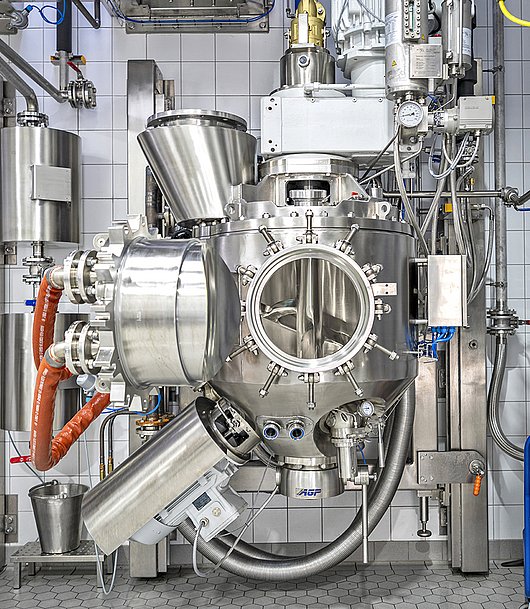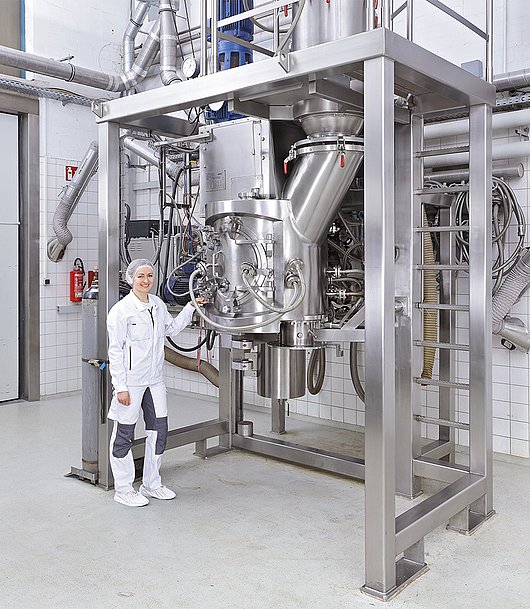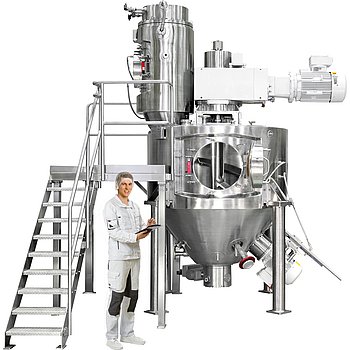Convection drying vs. contact drying

Convective drying is the most common method of thermal drying, as this type of drying equipment is comparatively simple to manufacture.
Convective dryers circulate hot air through and over the products, thus reducing the humidity of the atmosphere around the product and causing the solvent to evaporate. The hotter the air, the quicker the product will dry.
However, convection drying has its downsides. For one, excessively hot air can considerably detract from product quality. If the air is too hot, the solid surface of the product may harden and crust over. And because hot air exposes the products to oxidation, convection drying can cause significant degradation to nutritional and color properties, making it less than ideal for food drying. Furthermore, convection drying is highly energy-intensive.
Compared with convection drying, contact drying has the advantages of being more energy-efficient and controlled. The latter quality in particular makes contact drying ideal for working with combustible materials. Contact drying is the basic mass transfer principle used in most vacuum dryers.
VMT Vertical Vacuum Dryer and Mixing-Reactor by amixon®: High-performance 3-in-1 vacuum drying, mixing, and reacting equipment for use in food, pharmaceuticals, chemicals, and more. VMT dries ingredients under a vacuum using indirect contact mechanisms - every surface area within the chamber is jacketed and can be heated or cooled. This includes the mixing shaft and mixing blades.
What is vacuum drying?
Vacuum drying is a batch operation performed in an air-tight vessel. Using vacuum pumps, the pressure and humidity within the chamber are reduced. By lowering the atmospheric pressure within the chamber, the materials inside dry more quickly through contact with the indirectly heated walls. In this sense, vacuum drying is essentially contact drying in a vacuum.
Vacuum drying heat-sensitive materials
Vacuum drying is one of the foremost industrial drying techniques for heat-sensitive, hygroscopic, and/or toxic powders and granules. Avoiding excessive heat while drying powder may be necessary for a variety of reasons, ranging from product quality to safety:
- Pharmaceutical powders - active ingredients may lose their medicinal effect when warmed.
- Food drying - certain nutrients may break down if exposed to high temperatures. Taste, consistency, and appearance can also degrade under too much heat.
- Plastics and chemical processing – synthetic materials can leach toxins with prolonged exposure to heat. This can even make convection drying methods hazardous, as the hot air stream must eventually be emitted.
Vacuum drying is a safe and highly efficient technique for drying large volumes of heat-sensitive powders or granules at a much lower temperature than would be required in a traditional industrial dryer. In a vacuum, where ambient pressure is reduced, the flashpoint of liquids lowers considerably.
Because of their pressurized chambers, amixon® vacuum dryers are capable of reducing the flashpoint of a watery suspension from 212°F (or 100°C, the normal boiling point of water) to just 95°F (35°C). The vacuum drying process requires less heat to remove water from the product, thus using less energy and resulting in less product degradation than with traditional drying methods.

| Vacuum Dryer equipped with patented SinConvex® mixing blades: All amixon® vacuum drying models also function as ribbon blenders. Within the chamber, a top-mounted mixing shaft is outfitted with patented convex mixing blades. The tilted, helical mixing tool creates a three-dimensional flow within the bulk ingredients and discourages the build-up of material fines. | |
Mixing in a vacuum dryeramixon® models AMT and VMT are not exclusively vacuum dryers – they are also vacuum mixers. Both models are equipped with a spiral mixing blade to agitate the contents during the vacuum drying process. The intensity of the agitation can be adjusted, ranging from gentle homogenization to intensive deagglomeration. Each individual part of an amixon® vacuum dryer that comes into contact with the product is jacketed: from the walls of the vessel to the mixing arm to the mixing blades. This means that the entire internal chamber of the powder dryer can be heated or cooled, so there is an increased amount of surface area for thermal transfer. Furthermore, agitating the product by means of a spiral mixing blade does more than simply mix the ingredients. By creating a three-dimensional flow, heat is evenly distributed throughout the product, maximizing batch uniformity in the vacuum drying process. Mixing under a vacuum can also improve the dispersion quality of the final product, eliminate aesthetically displeasing voids, and impede microbial growth. |

Vacuum dryers as batch reactors
Because of their air-tight, pressurized vessels, amixon® vacuum drying machines can also be used as batch reactors.
The temperature and pressure conditions within the chamber can be tightly controlled, creating the ideal environment in which to carry out chemical reactions.
Furthermore, the vacuum dryer design lends itself to quick and easy cleaning between batches so that the same reactor mixer and powder dryer can be used to process different ingredients.

How is the vapor removed during vacuum drying?
Within the amixon® vacuum drying models, the exhaust vapor passes through a heated filter as it rises. After the filter catches and removes any dust particles, the vapor is then collected in a condenser and discharged through a vacuum pump.
These emissions are generally clean and do not pose any health hazards or environmental threats. To this extent, vacuum dryers are a closed-circuit system.

Common applications for vacuum dryers and reactor mixers
Vacuum drying is frequently used in food processing, pharmaceutical production, plastics manufacturing, ceramics, metallurgy, and chemical processing. Read more about the custom vacuum drying technology that amixon® has developed for diverse industries and applications:
Our powder dryers
Learn more about the specifications and capabilities of amixon® powder dryers and mixing reactors.
Speak with an amixon® representative about vacuum drying equipment
